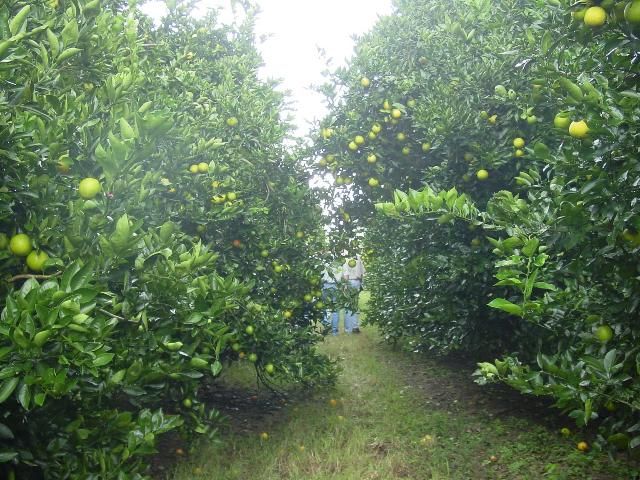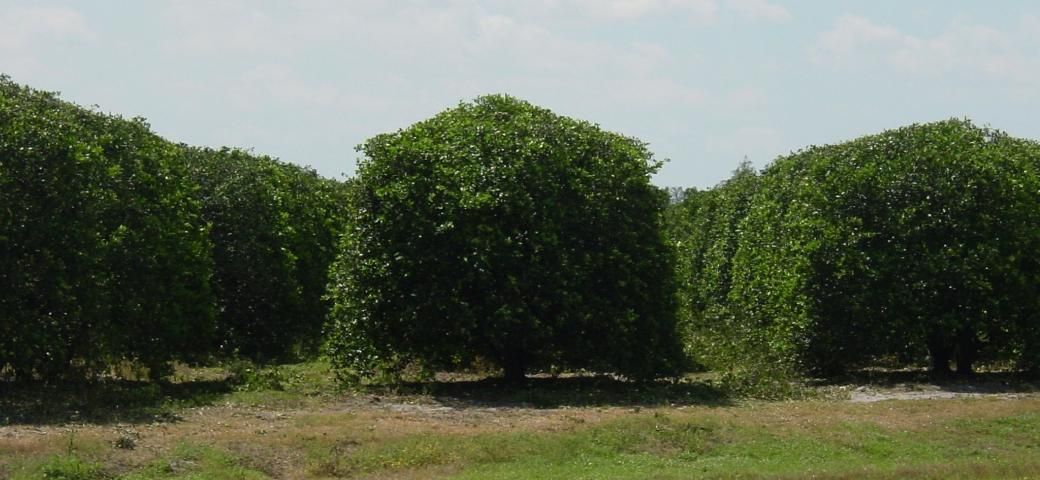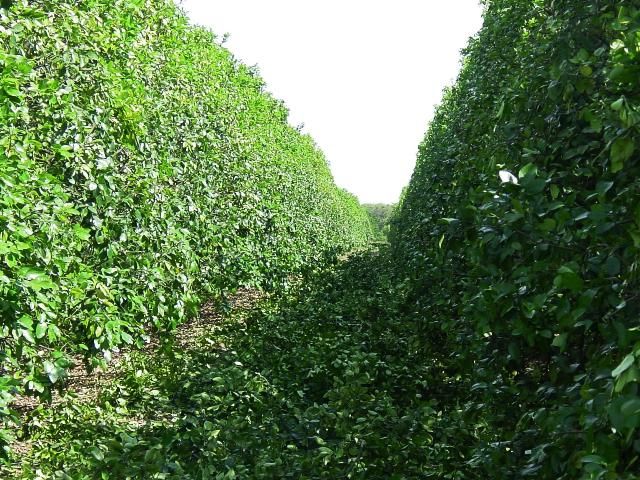Introduction
The interception and utilization of sunlight should be an important consideration in citrus grove design. The effect of insufficient light is frequently observed in mature citrus groves that are not pruned (hedged and topped) regularly. Shading reduces yield and foliage on the lower parts of the trees. Sunlight not only influences flowering and fruit set but also enhances fruit quality and color development. Increased sunlight penetration within the tree canopy might also allow foliage to dry more quickly after a rain shower and could help reduce establishment of fungal pathogens. Therefore, adjustments must be made in tree height and hedging angle to maximize sunlight interception.
Hedging and Topping
Hedging and topping are important cultural grove practices. Severe hedging or topping of citrus trees during the winter can reduce cold hardiness because trees with exposed internal scaffold wood and new tender growth are susceptible to cold injury.
In general, tree response to hedging and topping depends on several factors including variety, rootstock, tree age, growing conditions, time of pruning, and production practices. No one system or set of rules is adequate for the numerous situations encountered in the field. Growers are encouraged to gain a clear understanding of the principles involved in hedging and topping and to take advantage of research results, as well as consulting knowledgeable colleagues and custom operators for their observations.

Credit: Mongi Zekri, UF/IFAS
Hedging should be started before canopy crowding (Figure 1) becomes a problem. As a general rule of thumb, pruning branches greater than 0.13"–0.25" in diameter should be avoided. Developing a pro-active pruning program should assist managers in removing branches of the right size. Removal of a significant portion of the tree will result in excessive vegetative growth and a drastic reduction in subsequent yield. Hedging is usually done at an angle, with the boom tilted inward toward the treetops so that the hedged row middles are wider at the top than at the bottom. This angled hedging allows more light to reach the lower skirts of the tree. Hedging angles commonly used vary from 10 to 15 degrees from vertical.
Topping should be done before trees have become excessively tall and should be an integral part of a tree size maintenance program. Long intervals between toppings increase the cost of the operation due to heavy cutting and more brush disposal. Furthermore, excessively tall trees are more difficult and expensive to harvest and spray. Topping trees will improve fruit quality and increase size. Some common topping heights are 10 to 12 ft at the shoulder and 13 to 14 ft at the peak (Figure 2). As a general rule, topping heights should be two times the row middle width.

Credit: Mongi Zekri, UF/IFAS
After severe hedging or topping, heavy nitrogen applications will produce vigorous vegetative regrowth at the expense of fruit production. Therefore, nitrogen applications should be adjusted to the severity of hedging or topping. Reducing or omitting a nitrogen application before and possibly after heavy hedging will reduce both costs and excessive vegetative regrowth. Light maintenance hedging should not affect fertilizer requirements.
Large crops tend to deplete carbohydrates, which results in a reduced fruit yield and increased vegetative growth the following year. Pruning after a heavy crop additionally stimulates vegetative growth and reduces fruit yield the following year. Pruning after a light crop and before an expected heavy crop is recommended because it can help reduce alternate bearing, which can be a significant problem in Valencia and Murcott production.
Severe hedging may create problems of brush disposal (Figure 3) and may stimulate vigorous new vegetative growth, especially when done before a major growth flush. This happens because an undisturbed root system is providing water and nutrients to a reduced canopy area. The thicker the piece of wood that is cut, the larger the subsequent shoot growth will be. Severe pruning reduces fruiting and increases fruit size.

Credit: Mongi Zekri, UF/IFAS
Timing
The best time of year to hedge or top depends on variety, location, severity of pruning, and availability of equipment. Since pruning is usually done after removal of the crop, early maturing varieties are generally hedged before late maturing varieties. Most growers prefer to hedge before bloom, but trees will get more vegetative regrowth, which may not be desirable. Pruning could begin as early as November prior to harvesting in warmer areas. During this period, pruning operations should only cut minimal foliage and fruit from the trees.
Valencia trees may be hedged in late fall with only minimal crop reduction when the hedging process removes only a small amount of vegetative growth. In cases where excessive growth is to be removed, the trees are usually harvested before hedging is conducted. Light maintenance pruning can be done throughout the summer and until early fall with little or no loss in fruit production. Moderate to severe pruning should not continue into the winter in freeze-prone areas, as trees with tender regrowth are susceptible to cold injury.
Because of citrus canker and greening diseases, selecting the best time for hedging and topping is becoming more complicated. New growth flushes promoted by hedging and topping in late spring, during the summer, and early fall can increase the population of leafminers and psyllids and aggravate the spread of citrus canker and greening. Declining trees with defoliated tops, dieback, reduced cropping, and severe root loss due to citrus greening are being hedged and topped to help balance the shoot to root ratio, which improves tree performance and extends tree longevity.
Skirting
Skirting is the pruning that raises tree skirts (Figure 4). Without skirting, the movement of herbicide booms and mechanical harvesting equipment is impeded. Fruit and limbs near the ground are often damaged by the passage of such equipment and by herbicide spray and fertilizer contact. Skirting allows uniform distribution of granular fertilizers and good water coverage by microsprinkler irrigation systems under tree canopies. Skirting facilitates the inspection of microirrigation systems and reduces the incidence of Phytophthora foot rot and brown rot because it allows good air circulation.

Credit: Mongi Zekri, UF/IFAS
Conclusion
Pruning is an important grove care practice that has many advantages for citrus trees because pruning
- removes weak branches and rejuvenates trees,
- reduces shading and improves light interception,
- improves air circulation through the canopy and reduces pest and disease pressure,
- enhances tree performance,
- alleviates alternate bearing,
- increases fruit size and improves fruit quality, and
- facilitates harvesting.